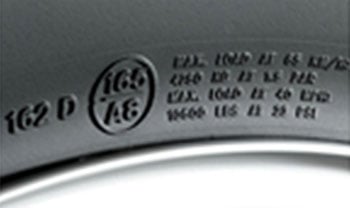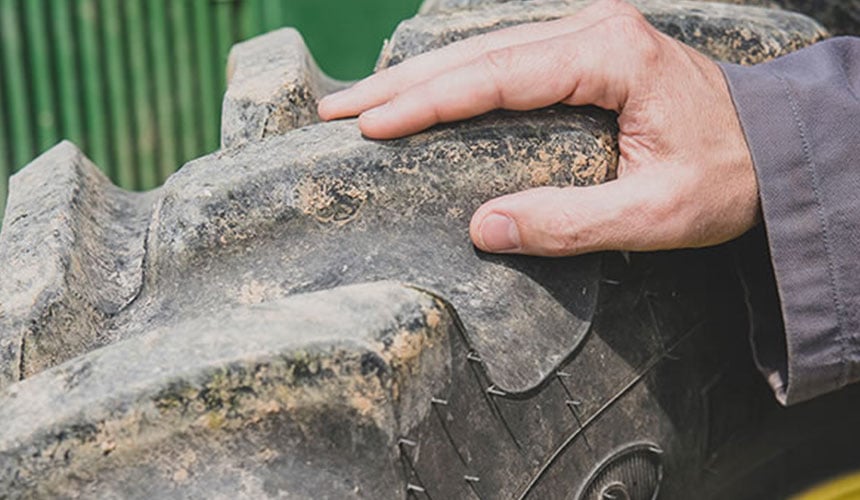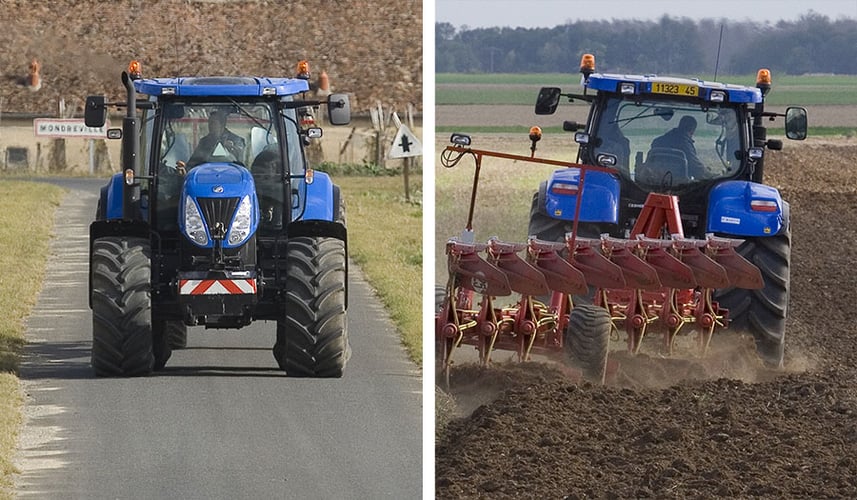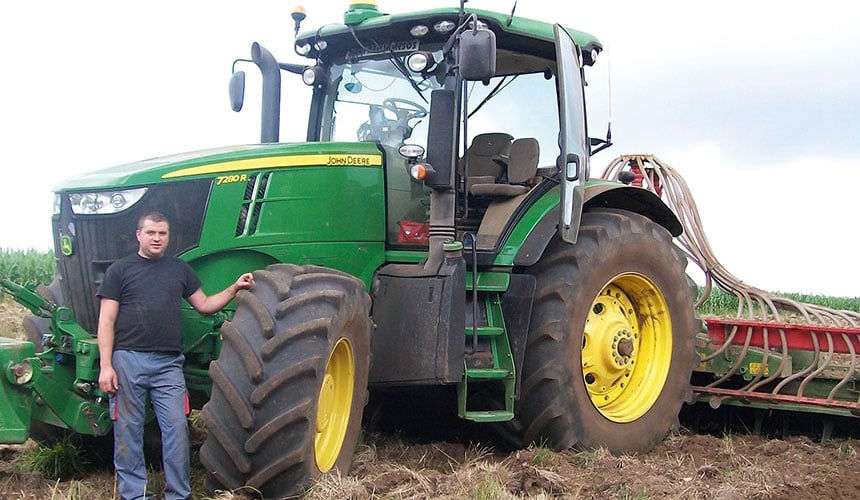Did you know that you could extend the useful life of your agricultural tyres considerably simply by following the indications which are inscribed on your tyres, such as the load and speed index?
You can also make your tyres last longer by maintaining them properly and by managing their storage better when they are not being used.
The simplest solution is to get a better understanding of the markings on the sidewall of your tyres. This will prevent you from using them for work that they were not designed for by the manufacturer and from ending up having to invest too often in a new set of tyres. This is what you should do to help make savings.
1. Decipher the markings on your tyres to optimise their lifespan
As for all tyres, whether agricultural or classical, important information is indicated on the tyre sidewall, in particular tyre characteristics and certifications. The purpose of this information is to help you optimise the use of your agricultural tyres and to work in the best possible conditions without having to replace them due to premature wear, for example.
Failure to follow certain indications such as the load or speed index may have a real impact on your purse-strings. To extend the life of your agricultural tyres, you must know how to decipher the information below.

on your tractor tyres
1. The basic information: brand, range, suppleness
The markings on an agricultural tyre sidewall provide various indications including the following basic information:
- The range: this corresponds to the family to which the agricultural tyre belongs and is presented in the form of category (standard, wide, narrow…).
- Suppleness: the most recent tyres are marked with the letters IF (Improved flexion) and VF (Very high flexion).
The letters IF and VF give you an additional indication on the load capacity of the agricultural tyre. IF technology indicates that the tyre can bear more than 20% additional weight and 40% for a VF tyre.
2. Agricultural tyre dimensions
Several criteria determine agricultural tyre dimensions. They may be expressed in millimetres or inches, depending on the brand and model.
Example in millimetres: 480/70 R 30
- 480: designates the width of the tyre section in millimetres, i.e. 480 mm.
- 70: corresponds to the tyre series or aspect ratio which is the height of the sidewall as a % of the section width.
- R: indicates the internal construction of the tyre (Radial). Radial tyres are ideal for ploughing, soil preparation and transport.
- 30: is the interior diameter of the tyre, i.e. the dimension of the rim. It is expressed in inches (1 inch = 25.4 mm).
GOOD TO KNOW: when the letter “D” or “–” is marked on the sidewall of an agricultural tyre instead of “R”, this means the tyre has a diagonal structure.
Example in inches: 16.9 R 30
- 16.9: represents the section expressed in inches.
- R: indicates a Radial construction.
- 30: designates the rim dimension.
GOOD TO KNOW: when the dimensions are only indicated in inches, this means they are essentially old tyres or they do not come from Europe.
3. Standard load index
Often next to the dimensions, the load index, as its name suggests, indicates the maximum load that can be borne by the agricultural tyre at standard pressure, i.e. 1.6 bar. The index generally ranges from between 100 to 200, with a few examples below:
Standard load index table
| INDEX | MAX LOAD | INDEX | MAX LOAD | |
| 100 | 800 kg | 172 | 6 300 kg | |
| 110 | 1 060 kg | 187 | 9 750 kg | |
| 130 | 1 900 kg | 189 | 10 300 kg | |
| 150 | 3 350 kg |
Complying with the load index established by the manufacturer allows you to optimise the lifespan of your agricultural tyres and avoid having to replace them frequently. If the load is not respected, the constituent materials will have a tendency to overheat on the road and deform excessively in the fields, leading to weaknesses and premature wear. In the worst case, this can cause more or less serious accidents, so it’s best to stay below the maximum recommended load.
When you have no choice but to work with heavy implements, the most efficient solution is to mount VF technology tyres, which can bear more weight. They have a reinforced casing which allows them to work in the field with a minimum pressure of 0.8 bar. In addition, they have the advantage of being able to increase the tractive force of your tractor and reduce your fuel consumption.
4. Speed index
This is the maximum forward speed which must not be exceeded to avoid excessive overheating of the rubber, or potentially an accident. The speed rating is always next to the load index and informs you about your agricultural tyre’s capacities. The indicated speed must be respected at all costs if your vehicle is loaded.
As opposed to the speed rating for a classical tyre, the rating for an agricultural tyre ranges from A1 to J as shown below:
Speed index table
| CODE | SPEED (km/h) | CODE | SPEED (km/h) | |
| A1 | 5 km/h | B | 50 km/h | |
| A2 | 10 km/h | C | 60 km/h | |
| A3 | 15 km/h | D | 65 km/h | |
| A4 | 20 km/h | E | 70 km/h | |
| A5 | 25 km/h | F | 80 km/h | |
| A6 | 30 km/h | G | 90 km/h | |
| A7 | 35 km/h | J | 100 km/h | |
| A8 | 40 km/h |
If you drive faster than the recommended speed, whether on the road or in the fields, your tyre will be solicited beyond its capacity and will wear prematurely.
5. Date of production of the agricultural tyre
This indication is often neglected although it is very useful when purchasing second hand agricultural tyres. It is made up of four figures:
- The first two: correspond to the week of production, from 1 to 52
- The last two: indicate the year of production, starting from 2000.
Example:
3013 = the tyre was produced in the thirtieth week of the year 2013.
If you know the age of your tyre, it will be simpler to estimate when to replace it.
2. A well maintained agricultural tyre lasts longer
Agricultural tyres are designed to last a long time, but numerous factors may cause them to deteriorate such as repeated incorrect tyre pressure settings or excess load. Regular tyre check-ups are necessary, especially before the new harvest. The check-up takes about ten minutes and ensures your safety as well as extending the lifespan of your tyres.
The tyre check-up can be carried out in two steps:
STEP 1: Check the tyres while the vehicle is stationary

This initial inspection will enable you to:
- Carry out a visual inspection for the presence of foreign bodies, anomalies or impacts: on the tyre sidewalls, the rim, the tread and the bead.
- Ensure there are no loose bolts or any sign of corrosion on the wheel bolts.
- Check that your tyres’ valve caps are present to limit the risk of loss of airtightness.
- Inspect the state of the tyre lugs to check for irregular wear.
- Adapt the pressure of your tyres to comply with manufacturer recommendations and the work that you are intending to carry out.
STEP 2: Check the tyres while the vehicle is moving

A second inspection should be carried out while driving on the road or in the fields. Be attentive and careful when you observe:
- Abnormal vibrations when driving: this may be caused by a mechanical fault, incorrect mounting or badly adapted inflation pressure.
- Abnormal swing or bounce: this is often linked to a bad mass ratio or overinflated tyres.
- A steering problem: this may stem from incorrect tyre pressure. Be careful, underinflation may lead to the tyre coming off the rim.
If you have any doubts, consult your usual tyre dealer who will be able to give you the advice you need.
3. Five tips for good storage of your agricultural tyres
During the winter, good storage of agricultural tyres will help to avoid unpleasant surprises when you take out your tractor for the next agricultural campaign.
Here are 5 tips for preserving and extending the lifespan of your tyres
- Clean your tyres before storing them:
Remove the gravel and earth stuck around the rim, then place the tyres upright to avoid weakening the casing. - Store your tyres inside:
Chose a place away from heat and humidity to avoid cracking. If your tyres are difficult or impossible to handle, use a waterproof tarpaulin to cover your tyres. - Keep your tyres away from chemical substances and sources of ozone:
Rubber is quick to absorb hydrocarbon and solvents which are elements that can rapidly deteriorate the rubber in the tyres. - Avoid direct contact with the ground:
If you don’t have storage racks, at the very least, place your tyres on a tarpaulin. - Change the position of your tyres regularly:
The casing will deform if the tyre stays in the same position for long periods. Rotating the tyre one quarter of a turn every month will suffice.
- If your tyres are not mounted on rims: keep them away from electrical machines, soldering equipment, engines, etc.
- If your tyres are on rims: store them flat or upright with the usual inflation pressure.
- If they are on the vehicle: keep them on a flat, non-abrasive surface or use chocks to position your agricultural vehicle.
4. Is it worth increasing the size of your tractor tyres?
Your agricultural vehicle’s original tyre mount, which is in general the most economic for the tractor manufacturer, is not necessarily the best adapted to your soil and your activity.
Depending on your needs, you can increase the carrying capacity of your tyres by up to 35 to 40% to boost your productivity.

By increasing the diameter of your wheels, you will optimise your performances. The benefits of this technique are multiple, but ensure that you always respect the original lead, which is calculated using the final drive ratio provided by the manufacturer specifications:
- The tyre’s contact surface with the ground will be wider: leading to less soil compaction.
- Slippage will be reduced: leading to less fuel consumption.
- The volume of air and the tyre mass increase: the tyre can therefore bear a greater load.
It is best to increase the diameter of the rear wheels of your tractor as much as possible when you need to work with heavy implements on heavy or loose soils, whatever the weather conditions. When choosing a tyre, opt for a minimum rim to ensure that the volume of air increases.
As for the choice of width of tyre, you should consider the nature of the work to be carried out:
- For ploughing: increasing the width of your tyres will improve their contact with the soil and optimise the tractor’s tractive force.
- For crop treatments: reduce the width when your tractor needs to pass between crop rows.
The Bridgestone-agriculture.eu blog is written and administered by tractor tyre experts who are available to provide you with the advice you need on the subject of your agricultural tyres. They allow you to maximise your productivity with information on all subjects linked to tyres: technical data for agricultural tyres – Agricultural tyre performance – Air pressure advice – Solutions to avoid soil compaction – Sprayer tyre pressure – Why and how to ballast your tractor tyres – etc.
To learn more and boost your farm's profits, Bridgestone-Agriculture is offering you a free, detailed white paper that explains the essential role your agricultural tyres play in your productivity.
Most people who read this article have also read some of the following articles:
- 5 essential techniques to optimise your agricultural tyres
- Should you change the rim for wide agricultural tyres?
- Is a premium rim better suited to my tractor tyres?
- What is the link between the environmental impact of tyres and your profitability
- Braking capacity: role and impact of the agricultural tyre
- Are adjustable rims better than welded rims?
- How reliable are your agricultural tyres when cornering?
- How do you ensure that your tractor tyres have a good self-cleaning capacity?
- What is the mechanical performance of an agricultural tyre?
- Why should you check your harvesting tyres before the start of the harvest?
This information is intended only to make you aware of the technical and functional aspects of agricultural tires and their use. It does not allow you to make a judgment or a definitive conclusion on a given problem. Only your agricultural tire expert is able to make a technical assessment and take a final decision, case by case.
Leave a
commentary
Your email address will not be published.
Required fields are indicated with *








